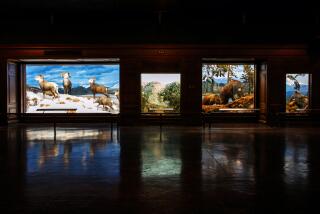LA CIENAGA AREA
- Share via
A tokonoma is the formal display area in a traditional Japanese living room. Consisting of a small stage with a vase placed in front of a scroll that is changed with the seasons, the tokonoma is given a contemporary interpretation in a show of new work by Tom Marioni. Known as a sculptor and conceptualist, Marioni has also worked extensively in video and as a performance artist, composer and curator; he’s currently shaping up to be something of an armchair travel guide.
His recent work grew out of an interest in theories concerning national identity, social contract and ritual--ideas that he greatly respects. Hence he’s very careful as to what liberties he takes when exploring them. The only ways in which Marioni’s tokonoma differs from one you might find in an ancient Oriental dwelling is in their erotic content and in his presentation of a series of 10 small shrines produced in an edition of 20. Beyond that, his tokonoma conforms to the standard recipe to the letter.
Also on view are two sculptural tableaux that are essentially three-dimensional still lifes designed to evoke specific periods or locales. Marioni takes us to Italy via an assemblage involving an elegantly finished Italian table, atop which sits a pizza cutter and cruets of oil and wine. The same premise applies to “The Japanese,” which incorporates a sword, cup, scroll and three beautifully crafted boxes. It’s a deeply reverential body of work; a group show on view in an adjoining gallery is the flip side of the coin.
An update and broadening of an exhibition titled “Pictures,” which was curated by Douglas Crimp in 1977, “Picture Perfect” offers a progress report on a number of the artists who were included in Crimp’s show. Juxtaposing old and new work by six leading Post-Modernists, “Picture Perfect” suggests that most of these artists are working in an increasingly baroque direction; the new work tends to be bigger, bolder and brighter than the old.
One of the goals of Post-Modernism was to reintroduce figurative imagery to the avant-garde, which had been in the grip of Minimalism and Conceptualism throughout the ‘70s. The PMs achieved that goal but theirs is a rather Pyrrhic victory. One of the party lines of this style is “representation freed from the tyranny of the represented,” which can also be read as figurative imagery emptied of content. It’s a questionable goal that these cool aesthetic surgeons are frighteningly good at. They present pictures with respective veneers of political conscience (Louise Lawler’s tract on the illusion of life style, titled “Well Being”), sex (Cindy Sherman--the Madonna of Post-Modernism--impersonating a deranged bag lady and a flirty starlet) and nostalgia (Sherrie Levine’s perfect imitation of photography by Walker Evans). Each and all a flashy sleight-of-hand turn, yet the work feels curiously enervated and flat. That this art might offer insightful commentary on contemporary life is small consolation--you walk away from it feeling duped. (Kuhlenschmidt-Simon Gallery, 9000 Melrose Ave., to Aug. 23.)
More to Read
The biggest entertainment stories
Get our big stories about Hollywood, film, television, music, arts, culture and more right in your inbox as soon as they publish.
You may occasionally receive promotional content from the Los Angeles Times.










